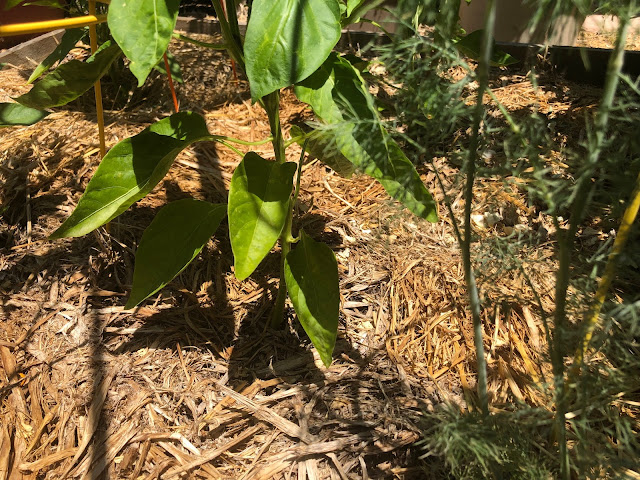
|
|
Pepper plants and dill are hanging in there during the heat with the help of a thick layer of straw mulch and some light shade protection. Short tomato cages are good for supporting shade cloth or plant flats.(Photo: Kathy Morrison)
|
Our extreme heat continues just a little longer. After back-to-back record 110-degree days, the last weekend of spring stays unseasonably hot with afternoon highs about 20 degrees above normal.
According to the National Weather Service, this heat can be deadly to people and pets. Add plants to that list, too. Avoid strenuous outdoor activity, drink plenty of water and pay attention to signs of heat stress or fatigue.
In case you were wondering, Sacramento’s all-time hottest June day was 115 degrees. Average for this week: 87.
In the garden, watch out for sunburned foliage, wilt and other signs of heat stress. Afternoon wilting is normal for large-leafed shrubs such as hydrangeas or big-leafed veggies such as melon or squash. But if they’re wilted in the morning, they need immediate hydration. For plants that are getting burned, erect some temporary shade. (Peppers and eggplants are especially susceptible.)
Don’t fertilize this week; wait until temperatures are cooler. Also, put off planting seeds or transplanting.
Plants in containers need special attention. They dry out quickly and pots heat up just as fast. Until temperatures subside, container plantings may need daily irrigation.
We should get a break in the heat soon – but only briefly. The weather service is predicting a return to the low 80s, with a high of 83 on Tuesday. But our relief is short-lived; we’ll likely be back to triple digits by Friday – and the first official weekend of summer.
* Let the grass grow longer. When it’s over 90 degrees, it barely grows at all. When you do mow, set the mower blades high to reduce stress on your lawn during summer heat. The longer grass shades the lawn’s roots and keeps them cooler. To cut down on evaporation, water your lawn deeply during the wee hours of the morning, between 2 and 8 a.m.
* Tie up vines and stake tall plants such as gladiolus and lilies. That gives their heavy flowers some support.
* Mulch, mulch, mulch! This “blanket” keeps moisture in the soil longer and helps your plants cope during hot weather.
* Avoid pot “hot feet.” Place a 1-inch-thick board under container plants sitting on pavement. This little cushion helps insulate them from radiated heat.
* Thin grapes on the vine for bigger, better clusters later this summer.
* Warm weather brings rapid growth in the vegetable garden, with tomatoes and squash enjoying the heat. Deep-water plants in early morning. When the weather cools, feed with bone meal to help fruit set.
* Generally, tomatoes need deep watering two to three times a week, but don't let them dry out completely. That can encourage blossom-end rot.
* Cut back Shasta daisies after flowering to encourage a second bloom in the fall.
* Trim off dead flowers from rose bushes to keep them blooming through the summer. Roses also benefit from deep watering.
* Pinch back chrysanthemums for bushier plants with many more flowers in September.
